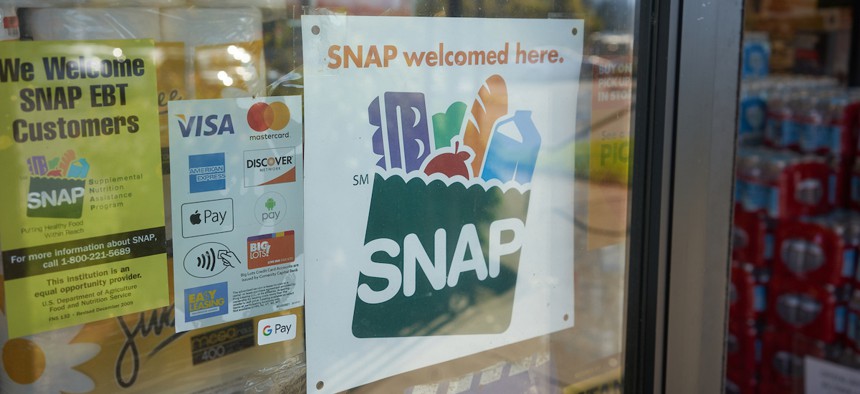How states can prepare to leverage AI for benefits eligibility

"SNAP welcomed here" sign is seen at the entrance to a Big Lots store in Portland, Oregon. hapabapa via Getty Images
As benefits application backlogs continue to mount, artificial intelligence could help ease the squeeze on already strained caseworkers, experts say.
Earlier this year, Tennessee and its Department of Human Services were served with a class action lawsuit from families and nonprofits in the state who claim the government failed to administer benefits under the Supplemental Nutrition Assistance Program, which offers financial support for low-income Americans to access food and groceries.
The plaintiffs claimed that delays like that violated federal requirements for the timely administration of benefits and left families to go hungry or choose between buying food and other necessities. The department, for instance, has reported that it could take an average of 129 days to process appeals for denied benefits.
“A lot of states have backlogs … and there's quite a few states that are not actually delivering benefits on the federal- mandated timeline, SNAP being one of them,” said Ariel Kennan, senior director of Georgetown University’s Beeck Center for Social Impact and Innovation. “The backlogs went up considerably during COVID, and some states really haven’t recovered from it.”
Adding to the challenge of benefits administration is the rise of the number of people with nontraditonal income, including gig workers like rideshare drivers or self-employed individuals, said Mike Bromley, senior vice president and general manager of government solutions at Equifax Workforce Solutions.
In many cases, nontraditional income sources don’t afford individuals standardized or stable income records with fluctuations in monthly wages, which can impact their eligibility for public assistance programs, he explained.
Those instances make it harder for already-strained caseworker resources to properly verify and distribute benefits, worsening backlogs as agency staff have to dedicate extra time and resources to review nontraditional workers’ income and other data, Bromley said.
As challenges with benefits eligibility and verification continue to mount, artificial intelligence and other automation tech could give government agencies an opportunity to streamline the complex processes, Kennan said.
Advancements in AI, such as the development of generative AI, have potential to “aid in the translation and standardization of eligibility rules in software code for these vital public benefits programs,” according to a March report from the Beeck Center.
Eligibility rules and requirements can be so complex that benefits program manuals can be thousands of pages long, creating a herculean effort for short-staffed caseworkers, Kennan said. This presents a great use case for agencies to leverage AI to query and summarize those intricate policies.
“The gap right now is that program manuals are not ready for AI,” Kennan said, as many policies are not digitally accessible or they are scattered across different websites that AI systems struggle to capture.
One step agencies can take to enable that AI integration is to prioritize the digitization of source material, so that large language models being developed to assist the determination process produce accurate and comprehensive outputs, according to the report. Agencies should, for instance, aim to translate policy manuals into a PDF document or plain-language HTML page that enables text extraction to ensure they are digitally accessible for LLMs.
Human review of policy code and source data is still an essential part of the process, as agencies explore AI’s potential to help improve government operations, Kennan added, particularly for use cases that could have significant impacts on people’s economic security.
“A lot of beneficiaries still want a human face and human support to benefits delivery when they're seeking help at really challenging moments in their time, and so we can't underplay that element,” she said.
Governments should also prioritize making the application process easier for those applying for benefits “at the front door,” to streamline the verification process for staff, Bromley said.
Rideshare drivers, for instance, have to collect and present individual receipts for caseworkers to sift through. Staff whose main job should be linking people with benefits in a timely manner “become an accountant [and] have to reconcile receipts in order to determine both gross and net income … that just elongates the process,” he explained.
That’s where tech like automation comes into play to expedite the process. Missouri, for instance, is leveraging automation to allow gig workers to upload income information like Uber receipts or Venmo payments to a platform that generates income reports for caseworkers to review.
Services like that can help reduce the amount of times a caseworker has to reverify income information with applicants or minimize the risk of errors in data entry and collection, which often further delays benefits processing, Bromley said.
Ultimately, public servants “want to serve and make people’s lives better,” Kennan said, and AI can help them “be even better at serving the public.”






